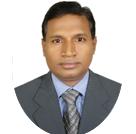
Prof. Md. Abdul Karim
Laboratory of Microbiology, Department of Botany, University of Dhaka, BangladeshSpeech Title: Isolation, molecular characterization and antibiogram of gut microbiota of snakeheads (Channa punctatus, C. striata and C. marulius)
Abstract: The gut microbiota plays an essential role for the health of fishes. It also gives the information of the immune system, feeding behavior and surrounding environment in which the fish lives. So, the present study aimed to compare the interspecies gut microbial abundance in snake heads (Channa punctatus, C. marulius and C. striata) from different habitats. Samples were collected from Brahmaputra river, Narayanganj, Buriganga river, Dhaka and Chinadi beel, Shibpur, Narsingdi. For the quantitative and qualitative study, four types of culture media (PYG, EMB, Cetrimide and TCBS) were used for the isolation of heterotrophic bacteria, coliform, Pseudomonas aeruginosa and Vibrio respectively.
Bacterial count on PYG, EMB, TCBS and Cetrimide agar media for Chana punctatus found to be ranged 1.0 × 107 - 1.1 × 106, 4.25 × 105 - 2.75 × 104, 4.0 × 103 - 2.0 × 103 and 1.48 × 104 cfu/g respectively from Buriganga river and for Chana marulius and C. striata that is 3.06 × 104 to 3.12 × 104, 1.97 × 104 to 4.62 × 104, 0 and 3 × 102 to 1.05 × 103 cfu/g respectively from Brahmaputra river samples. Whereas, in case of Chinadi beel, total bacterial count (TBC) in PYG medium was found to be ranged 1.15× 105 - 8.5 × 104 cfu/g. On EMB agar and TCBS medium that was recorded as 1.0 × 103 cfu/g for both but no bacterial growth was found on Cetrimide agar medium from Chana punctatus. The bacterial count from Chana marulius and C. striata in four medium was ranged 2.78 × 104 to 3.75 × 104, 1.2 × 103 to 1.3× 103, 3.6 × 103 to 7.5×102 and 2×102 cfu/g, respectively. During study total 337 bacterial colonies were isolated from which 71 isolates (32 Gram positive and 39 Gram negative) were selected for further study.
The identified Gram positive bacteria were Bacillus alvei (1), B. pantothenticus (1), B. cereus (3), B. firmus (1), B. polymyxa (3), B. subtilis (6), B. pumilus (1), B. coagulans (2), B. schlegelii (1), B. licheniformes (2), B. megaterium (1), B. aerophilus (1), B. pakistanensis (1), B. thuringiensis (1), Bacillus spp. (2) and Staphylococcus arlettae (1), B. licheniformes (3), and Micrococcus sp. (1). The Gram-negative included Pseudomonas aeruginosa (2), Enterobacter aerogenes (1), Enterobacter cloacae (1), Vibrio parahaemolyticus (2), Klebsiella pneumoniae (5), Salmonella enteritidis (2), Escherichia coli (2), Enterobacter spp. (2) and Citrobacter sp. (1), Enterobacter sp. (5), Citrobacter sp. (5), Pseudomonas fluorescens (4), Citrobacter diversus (2), Salmonella sp. (2), Pseudomonas sp. (1) and Kluyvera cryocresens (2). 16S ribosomal RNA also confirmed the molecular identification of 7 of the isolates similar to their provisional identification.
The selected 71 isolates were tested for their susceptibility to different antibiotics including Cefotaxime, Nalidixic acid, Gentamycin, Ciprofloxacin and Erythromycin. Maximum susceptibility found to Ciprofloxacin, whereas all the isolates showed maximum resistant activity to a commonly used antibiotic Gentamycin and Erythromycin indicating that off-label medicines were utilized.
The present study revealed that the gut microbiota isolated from C. striata was higher than C. marulius are responsible for fish diseases that might be caused of human diseases.
Biography: Dr. Md. Abdul Karim is a Professor and Principal Investigator of bioremediation of wastewater, microbiota in fish guts and seasonal dynamics of bioaerosols in the capital city in the Environmental Microbiology and Biotechnology Laboratory, Department of Botany, University of Dhaka, Dhaka 1000. He earned his PhD at Ehime University, Japan. Research in his lab focuses on understanding of how to evaluate and control microbial activities in eutrophic environments. His current project includes 1) Bioremediation of eutrophic environments, 2) seasonal variation of bioaerosols, 3) Characterization of hydrocarbon and textile dye degrading bacteria, 4) Isolation and characterization of multidrug resistant bacteria from environmental samples and hospital wastes; 5) microbiota in fish guts and their antibiogram; and 6) Understanding of how pathogenic bacteria can survive longer period in adverse condition in association with other microorganisms and their interrelationship. He has supervised over 31 postgraduates and PhD. He has published 65 peer-reviewed papers in microbiology, author of 12 book chapters and 3 research books.
Prof. Karim is a member of editorial board of Bangladesh Journal of Botany (BJB); Science International; World Journal of Applied Sciences; International Journal of Biosciences; Journal of Biodiversity and Environmental Sciences; Microbiology Research International, Journal of Biological Sciences. He was awarded by University Grants Commission in the recognition of his outstanding performance in his field.

